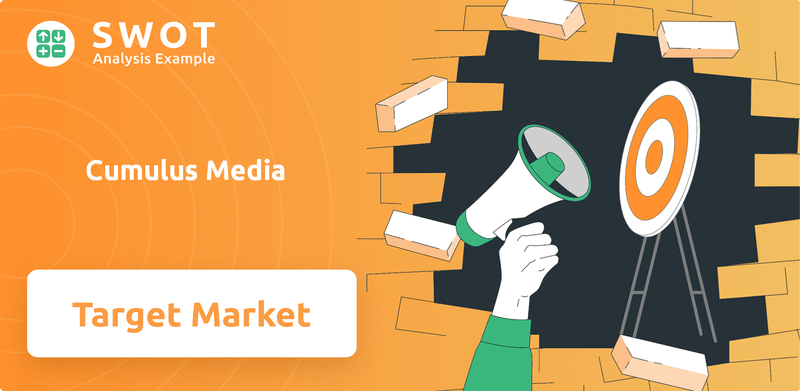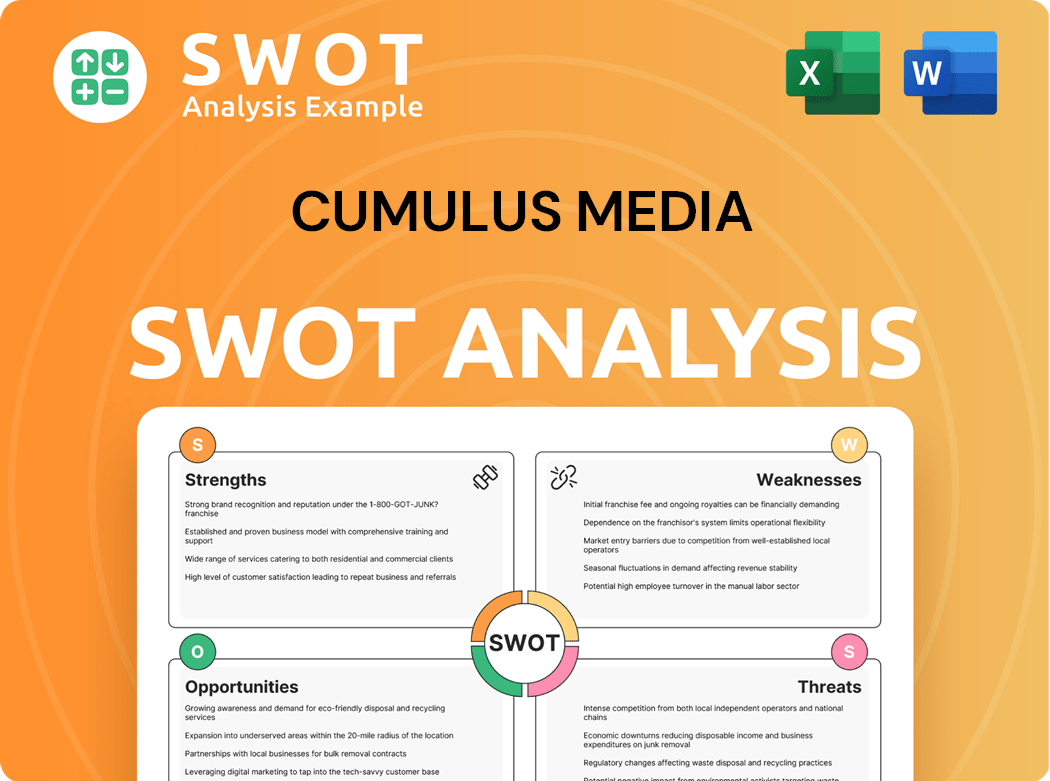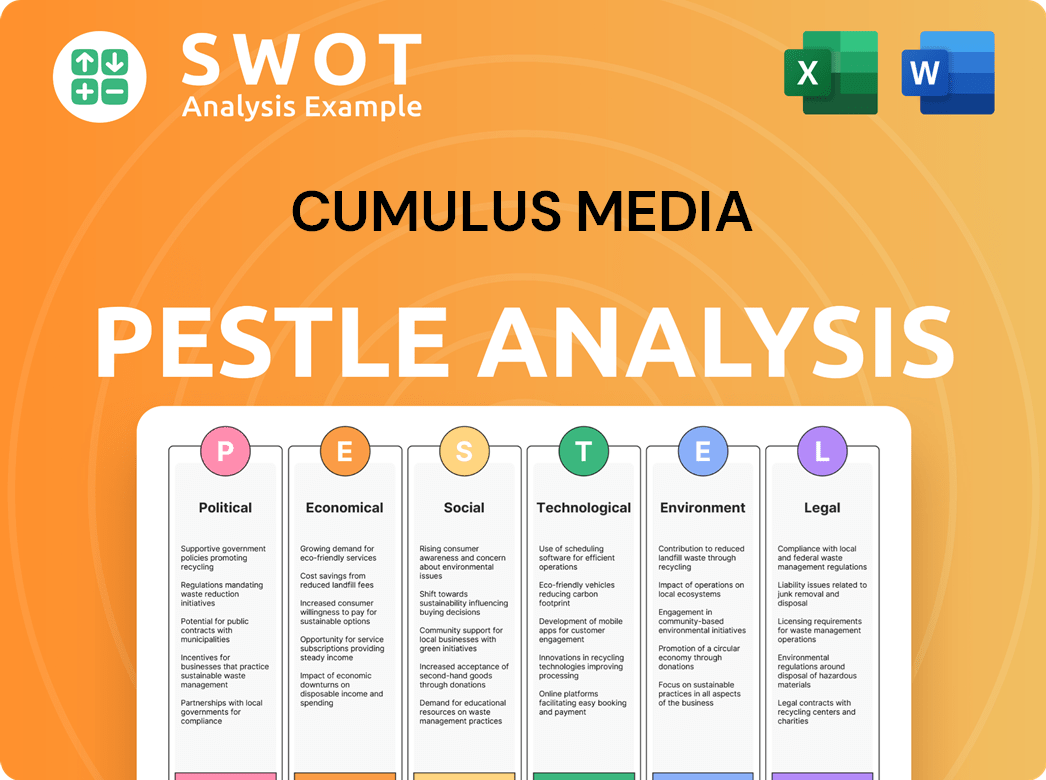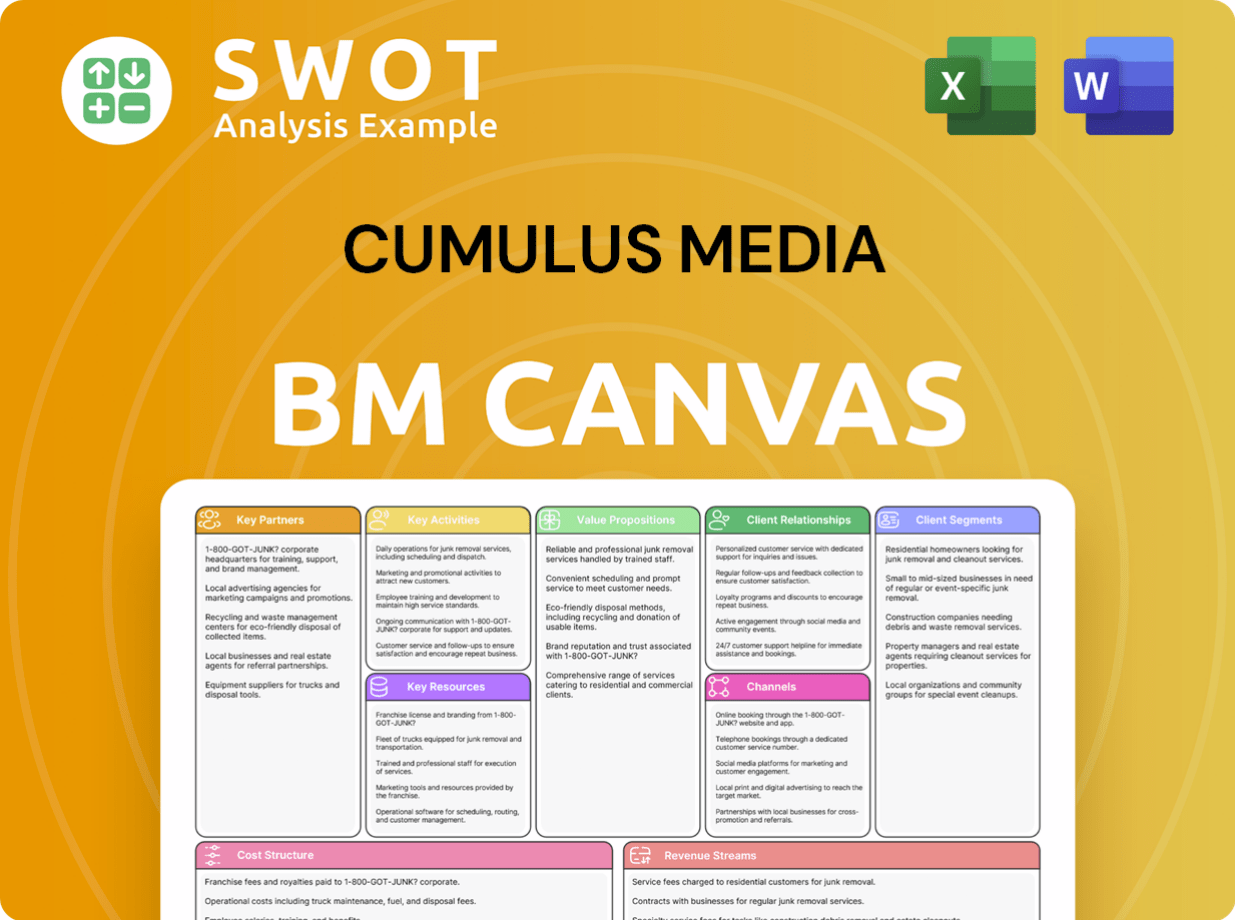Cumulus Media Bundle
Who Does Cumulus Media Really Reach?
In an audio landscape transformed by digital disruption, understanding the Cumulus Media SWOT Analysis is key. Cumulus Media, once synonymous with terrestrial radio, has had to adapt to the changing preferences of its audience. This shift necessitates a deep dive into its current customer demographics and target market.

This exploration will dissect the Cumulus Media target audience, from radio listeners to podcast consumers, examining their age, gender, income, and geographic distribution. We'll analyze how the media company audience has evolved, revealing strategies for effective advertising and audience engagement in today's dynamic audio world, including advertising demographics.
Who Are Cumulus Media’s Main Customers?
Understanding the customer demographics and target market of Cumulus Media is crucial for grasping its business model. Cumulus Media, as a leading media company, caters to a diverse audience through its various platforms. This includes both consumers and businesses, each with distinct characteristics and needs. Focusing on these segments helps clarify Cumulus Media's strategic direction and revenue streams.
The company's approach involves a dual focus: reaching individual consumers with content and providing advertising solutions to businesses. The consumer side is primarily about content consumption, while the business side is about advertising revenue. This structure allows Cumulus Media to leverage its content to attract audiences and then monetize that audience through advertising sales.
The company's primary customer segments are well-defined, with specific demographics that guide content creation and advertising strategies. This segmentation is essential for Cumulus Media's revenue generation and market positioning. For more information about the company, you can read Owners & Shareholders of Cumulus Media.
Cumulus Media's B2C segment is primarily composed of radio listeners and podcast consumers. The core demographic for traditional radio typically includes adults aged 25-54, with varying income and education levels depending on the station format. Podcast listeners, especially those engaging with the Westwood One Podcast Network, tend to be younger, often aged 18-34, and are more tech-savvy.
On the B2B side, Cumulus Media serves advertisers, ranging from local SMBs to national brands. These businesses use Cumulus Media's platforms to reach their target audiences. Local businesses often focus on geographic reach, while national advertisers seek broader demographic targeting across various audio platforms. Digital audio and podcast advertising represent the fastest-growing segment.
The target market for Cumulus Media varies across its platforms. Radio listeners are generally older, while podcast listeners are younger and more digitally engaged. Advertisers leverage these insights to tailor their campaigns. The shift towards digital audio has been significant, with podcast advertising experiencing substantial growth.
- Radio Listeners: Typically aged 25-54, with diverse income levels.
- Podcast Listeners: Often aged 18-34, with higher disposable incomes.
- Advertisers: Include local SMBs and national brands.
- Advertising Focus: Shift towards digital audio and podcast sponsorships.
Cumulus Media SWOT Analysis
- Complete SWOT Breakdown
- Fully Customizable
- Editable in Excel & Word
- Professional Formatting
- Investor-Ready Format

What Do Cumulus Media’s Customers Want?
Understanding the customer needs and preferences is crucial for a media company like Cumulus Media. The company's success hinges on its ability to cater to both its listeners (B2C) and advertisers (B2B). This involves providing engaging content for listeners while offering effective advertising solutions for businesses.
For listeners, the primary needs revolve around content, convenience, and connection. Advertisers, on the other hand, are driven by the need for effective reach, measurable results, and integrated marketing solutions. Cumulus Media must continually adapt its offerings to meet these evolving demands in the dynamic media landscape.
Cumulus Media's approach to understanding its audience is multifaceted, involving data analysis and direct feedback. This allows the company to refine its content and advertising strategies, ensuring it remains relevant and competitive. The company's ability to adapt to these needs is critical for its continued success.
Listeners of Cumulus Media value content that is engaging, informative, and entertaining. They seek a variety of formats, including music, news, talk shows, and podcasts. Convenience is also key, with many listeners consuming content while commuting, working, or during leisure time.
Advertisers prioritize reaching their target audience effectively and measuring the impact of their campaigns. They need platforms that offer targeted advertising solutions, clear reporting metrics, and efficient campaign management. This drives their decisions on where to invest their advertising budgets.
Podcast listeners have specific preferences, including on-demand access, niche content, and the ability to listen at their own pace. They often consider content relevance, host personality, and production quality when choosing what to listen to. This segment is growing, influencing Cumulus Media's content strategy.
Cumulus Media offers targeted advertising solutions across its radio and digital platforms. It leverages listener data to optimize campaign effectiveness. This includes tailored marketing pitches to specific industries, demonstrating how its audio assets reach desired customer segments. This approach helps advertisers achieve their goals.
The demand for digital solutions has significantly influenced Cumulus Media's product development. This has led to enhanced digital advertising capabilities and the expansion of its podcast network to offer more robust programmatic advertising options. These enhancements cater to the evolving needs of advertisers.
Cumulus Media uses data to understand its audience. This data includes listener demographics, listening habits, and content preferences. This information helps the company tailor its programming and advertising offerings to better meet the needs of both listeners and advertisers. This approach is crucial for its long-term success.
The customer demographics for Cumulus Media are diverse, reflecting the broad appeal of radio and podcast content. Understanding these demographics is essential for both content creation and advertising sales. The target market includes a wide range of age groups, income levels, and geographic locations. Advertisers often seek to reach specific segments within this audience.
- Radio Listeners: According to recent data, radio reaches approximately 93% of the U.S. adult population each month. The average age of radio listeners varies by format, with some formats attracting younger audiences and others skewing older.
- Podcast Listeners: Podcast listeners tend to be younger and more affluent than the general population. A significant portion of podcast listeners are between the ages of 25 and 54. Podcast advertising revenue continues to grow, reflecting the increasing importance of this segment.
- Advertising Demographics: Advertisers are particularly interested in the demographics of the Cumulus Media audience to ensure their campaigns reach the right people. This includes age, gender, income, and geographic location. The ability to target specific demographics is a key selling point for Cumulus Media.
- Geographic Target Market: Cumulus Media's geographic reach is extensive, with stations and digital platforms serving various local markets across the United States. This allows advertisers to target specific regions or nationwide audiences.
- Income Levels: Listener income levels vary depending on the radio format and podcast content. Advertisers often target specific income brackets to align with their product or service offerings.
- Advertising Strategies: Effective advertising strategies for Cumulus Media's target market involve understanding the preferences of both listeners and advertisers. This includes creating engaging content and offering targeted advertising solutions. For more insights, check out the Competitors Landscape of Cumulus Media.
Cumulus Media PESTLE Analysis
- Covers All 6 PESTLE Categories
- No Research Needed – Save Hours of Work
- Built by Experts, Trusted by Consultants
- Instant Download, Ready to Use
- 100% Editable, Fully Customizable

Where does Cumulus Media operate?
The geographical market presence of Cumulus Media is extensive, primarily due to its vast network of radio stations and the national reach of its Westwood One Podcast Network. The company strategically distributes its radio stations across various regions in the United States, ensuring localized content and advertising solutions. This approach allows Cumulus Media to cater to diverse audiences and advertising needs across different areas.
Major metropolitan areas like New York, Los Angeles, Chicago, Dallas, and Atlanta are key markets where Cumulus Media holds a strong market share. The company's ability to offer region-specific news, weather, and traffic, along with community-focused programming, is a critical factor in its success. This localization strategy allows Cumulus Media to remain relevant and competitive in diverse geographic landscapes, providing targeted campaigns for advertisers seeking to reach specific local audiences.
Differences in customer demographics, preferences, and buying power are evident across these regions. For example, a country music station in a rural market will cater to a different demographic than a talk radio station in a major urban center. This understanding is crucial for Cumulus Media to tailor its programming and advertising strategies effectively. The company's focus on key markets allows it to achieve economies of scale and leverage its existing infrastructure, ensuring its offerings remain relevant and competitive.
Cumulus Media's radio stations have a significant presence across the U.S., reaching millions of radio listeners weekly. The company's market share varies by market, with strong positions in major metropolitan areas. This wide reach enables Cumulus Media to offer advertisers extensive opportunities to connect with their target market.
Cumulus Media tailors its programming to local preferences, providing region-specific news, weather, and community-focused content. This localization strategy enhances listener engagement and attracts a diverse media company audience. The company's ability to adapt to local tastes is key to maintaining its competitive edge.
Cumulus Media provides targeted advertising campaigns that reach specific local audiences. Advertisers can leverage the company's extensive network to deliver relevant messaging. This approach is critical for businesses looking to maximize their advertising ROI.
Cumulus Media consistently adapts its local programming and sales strategies to align with evolving market dynamics and local listener preferences. This adaptability ensures that its offerings remain relevant and competitive. Marketing Strategy of Cumulus Media plays a crucial role in this process.
Cumulus Media Business Model Canvas
- Complete 9-Block Business Model Canvas
- Effortlessly Communicate Your Business Strategy
- Investor-Ready BMC Format
- 100% Editable and Customizable
- Clear and Structured Layout

How Does Cumulus Media Win & Keep Customers?
Customer acquisition and retention strategies are crucial for the success of Cumulus Media, a prominent player in the media industry. The company employs distinct strategies for both its listeners (B2C) and its advertisers (B2B), recognizing the unique needs and behaviors of each group. These strategies are constantly evolving to adapt to the changing media landscape and audience preferences.
For listeners, the focus is on attracting and retaining audiences through compelling content and community building. For advertisers, the emphasis is on demonstrating the value of advertising on their platforms and providing excellent service. This dual approach enables the company to maintain a strong market position and drive revenue growth.
The company's approach to customer acquisition and retention is multifaceted, leveraging both traditional and digital channels. It continually refines its strategies to stay competitive and meet the evolving demands of its audience and advertisers.
Acquiring listeners involves a mix of traditional radio promotion and digital marketing. This includes promoting stations across the network and using digital channels such as social media and SEO. Partnerships with content creators are also a key strategy.
Retention is achieved through high-quality content and fostering community around popular shows. Personalizing content recommendations and advertising experiences using listener data is also important. This includes using data analytics to understand listener preferences.
A strong direct sales force targets local and national businesses, emphasizing the reach of audio platforms. Marketing includes industry trade shows, digital advertising, and content marketing showcasing case studies. This also includes data-driven strategies.
Retaining advertisers involves demonstrating strong ROI, providing excellent customer service, and offering integrated advertising solutions. CRM systems are used to manage client relationships and track campaign performance. This includes offering flexible ad solutions.
Recent strategic shifts emphasize digital advertising solutions and programmatic buying for podcasts, reflecting the demand for efficient ad placements. This aims to enhance advertiser lifetime value by improving targeting and measurement. These strategies ultimately impact customer loyalty and reduce churn rates.
The company is increasing its focus on digital advertising and podcasting, reflecting the growth in these areas. This includes expanding digital advertising solutions and programmatic buying options. This is a key part of their growth strategy.
Using data to personalize content and advertising is a critical strategy. This includes using CRM systems to manage client relationships and track campaign performance. Data helps to improve targeting and measure effectiveness.
Demonstrating strong ROI to advertisers is crucial for retention. Offering integrated advertising solutions and providing excellent customer service are key. This helps maintain and grow advertiser relationships.
Personalizing content recommendations and advertising experiences is a key strategy. This involves understanding listener preferences through data analytics. The goal is to keep listeners engaged.
Fostering community around popular shows is an essential strategy for retaining listeners. This includes creating interactive experiences and encouraging listener engagement. Building community enhances loyalty.
The company is increasing its use of programmatic buying for podcasts. This allows for more efficient ad placements and better targeting. This helps advertisers reach their desired audience.
Cumulus Media Porter's Five Forces Analysis
- Covers All 5 Competitive Forces in Detail
- Structured for Consultants, Students, and Founders
- 100% Editable in Microsoft Word & Excel
- Instant Digital Download – Use Immediately
- Compatible with Mac & PC – Fully Unlocked

Related Blogs
- What are Mission Vision & Core Values of Cumulus Media Company?
- What is Competitive Landscape of Cumulus Media Company?
- What is Growth Strategy and Future Prospects of Cumulus Media Company?
- How Does Cumulus Media Company Work?
- What is Sales and Marketing Strategy of Cumulus Media Company?
- What is Brief History of Cumulus Media Company?
- Who Owns Cumulus Media Company?
Disclaimer
All information, articles, and product details provided on this website are for general informational and educational purposes only. We do not claim any ownership over, nor do we intend to infringe upon, any trademarks, copyrights, logos, brand names, or other intellectual property mentioned or depicted on this site. Such intellectual property remains the property of its respective owners, and any references here are made solely for identification or informational purposes, without implying any affiliation, endorsement, or partnership.
We make no representations or warranties, express or implied, regarding the accuracy, completeness, or suitability of any content or products presented. Nothing on this website should be construed as legal, tax, investment, financial, medical, or other professional advice. In addition, no part of this site—including articles or product references—constitutes a solicitation, recommendation, endorsement, advertisement, or offer to buy or sell any securities, franchises, or other financial instruments, particularly in jurisdictions where such activity would be unlawful.
All content is of a general nature and may not address the specific circumstances of any individual or entity. It is not a substitute for professional advice or services. Any actions you take based on the information provided here are strictly at your own risk. You accept full responsibility for any decisions or outcomes arising from your use of this website and agree to release us from any liability in connection with your use of, or reliance upon, the content or products found herein.